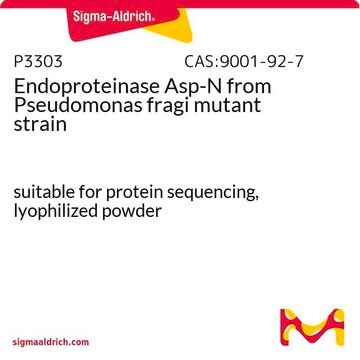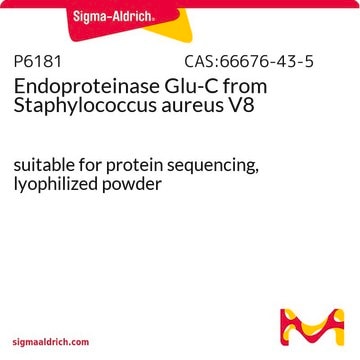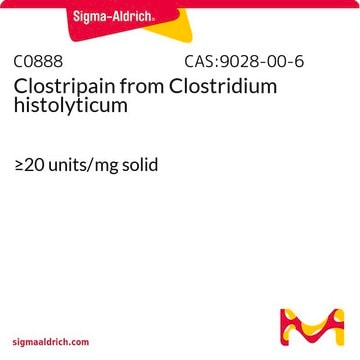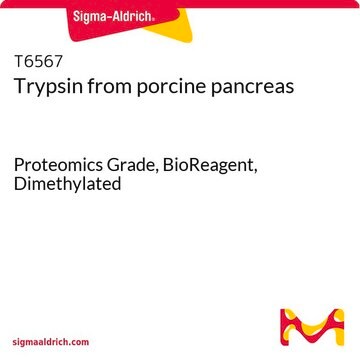P6056
Endoproteinase Arg-C from mouse submaxillary gland
suitable for protein sequencing, lyophilized powder
Sign Into View Organizational & Contract Pricing
All Photos(1)
About This Item
CAS Number:
EC Number:
MDL number:
UNSPSC Code:
12352202
NACRES:
NA.56
Recommended Products
form
lyophilized powder
packaging
vial of 5 μg
suitability
suitable for protein sequencing
storage temp.
−20°C
Looking for similar products? Visit Product Comparison Guide
Application
Endoproteinase Arg-C from mouse submaxillary gland has been used to study the syncytium formation in MERS-CoV (middle East respiratory syndrome coronavirus)-infected Vero cells in the presence of exogenous proteases. It has been used for the digestion of Rpl23ab (ribosomal protein L23ab)-containing fraction for LC-MS (liquid chromatography–mass spectrometry)/MS analysis.
Biochem/physiol Actions
Endoproteinase Arg-C is a serine endoprotease from mouse submaxillary gland which hydrolyzes peptide bonds at the carboxyl side of arginyl residues. The enzyme has been shown to cleave Lys-Lys and Lys-Arg bonds, and all Arg-X bonds may not be hydrolyzed.
Unit Definition
One unit will hydrolyze 1.0 μmole of Nα-p-tosyl-L-arginine methyl ester per min at pH 8.0 at 25 °C.
Signal Word
Danger
Hazard Statements
Precautionary Statements
Hazard Classifications
Eye Irrit. 2 - Resp. Sens. 1 - Skin Irrit. 2 - STOT SE 3
Target Organs
Respiratory system
Storage Class Code
11 - Combustible Solids
WGK
WGK 3
Choose from one of the most recent versions:
Already Own This Product?
Find documentation for the products that you have recently purchased in the Document Library.
Customers Also Viewed
Proteomics in Functional Genomics: Protein Structure Analysis (2000)
J R Casas-Finet et al.
Proceedings of the National Academy of Sciences of the United States of America, 89(3), 1050-1054 (1992-02-01)
To identify the functional residues of the N-terminal B region of bacteriophage T4 gene 32 protein involved in its cooperative binding to single-stranded nucleic acids, a process dependent on homotypic protein-protein interaction, we have studied the interaction of the protein
Middle East respiratory syndrome coronavirus infection mediated by the transmembrane serine protease TMPRSS2.
Shirato K, et al.
Journal of Virology, 87, 12552-12552 (2013)
Tanya R Porras-Yakushi et al.
The Journal of biological chemistry, 281(47), 35835-35845 (2006-09-29)
The ribosomal protein L12ab (Rpl12ab) in Saccharomyces cerevisiae is modified by methylation at both arginine and lysine residues. Although the enzyme responsible for the modification reaction at arginine 66 has been identified (Rmt2), the enzyme(s) responsible for the lysine modification(s)
Tanya R Porras-Yakushi et al.
The Journal of biological chemistry, 282(17), 12368-12376 (2007-03-01)
Ribosomal protein L23ab is specifically dimethylated at two distinct sites by the SET domain-containing enzyme Rkm1 in the yeast Saccharomyces cerevisiae. Using liquid column chromatography with electrospray-ionization mass spectrometry, we determined that Rpl23ab purified from the Deltarkm1 deletion strain demonstrated
Protocols
An optimized LC-MS/MS based workflow for low artifact tryptic digestion and peptide mapping of monoclonal antibody, adalimumab (Humira) using filter assisted sample preparation (FASP).
Our team of scientists has experience in all areas of research including Life Science, Material Science, Chemical Synthesis, Chromatography, Analytical and many others.
Contact Technical Service












